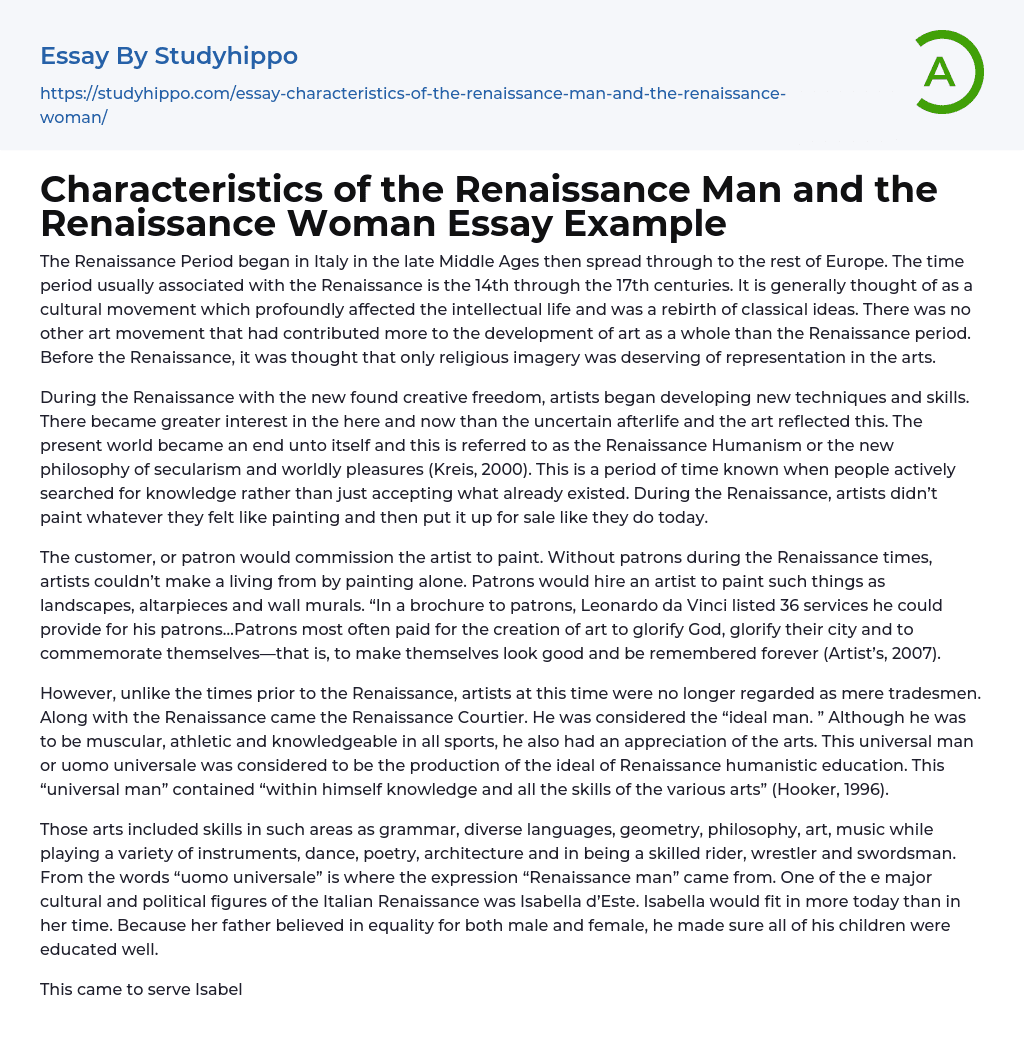

Characteristics of the Renaissance Man and the Renaissance Woman Essay Example
The Renaissance Period began in Italy in the late Middle Ages then spread through to the rest of Europe. The time period usually associated with the Renaissance is the 14th through the 17th centuries. It is generally thought of as a cultural movement which profoundly affected the intellectual life and was a rebirth of classical ideas. There was no other art movement that had contributed more to the development of art as a whole than the Renaissance period. Before the Renaissance, it was thought that only religious imagery was deserving of representation in the arts.
During the Renaissance with the new found creative freedom, artists began developing new techniques and skills. There became greater interest in the here and now than the uncertain afterlife and the art reflected this. The present world beca
...me an end unto itself and this is referred to as the Renaissance Humanism or the new philosophy of secularism and worldly pleasures (Kreis, 2000). This is a period of time known when people actively searched for knowledge rather than just accepting what already existed. During the Renaissance, artists didn’t paint whatever they felt like painting and then put it up for sale like they do today.
The customer, or patron would commission the artist to paint. Without patrons during the Renaissance times, artists couldn’t make a living from by painting alone. Patrons would hire an artist to paint such things as landscapes, altarpieces and wall murals. “In a brochure to patrons, Leonardo da Vinci listed 36 services he could provide for his patrons…Patrons most often paid for the creation of art to glorify God, glorify their city and
to commemorate themselves—that is, to make themselves look good and be remembered forever (Artist’s, 2007).
However, unlike the times prior to the Renaissance, artists at this time were no longer regarded as mere tradesmen. Along with the Renaissance came the Renaissance Courtier. He was considered the “ideal man. ” Although he was to be muscular, athletic and knowledgeable in all sports, he also had an appreciation of the arts. This universal man or uomo universale was considered to be the production of the ideal of Renaissance humanistic education. This “universal man” contained “within himself knowledge and all the skills of the various arts” (Hooker, 1996).
Those arts included skills in such areas as grammar, diverse languages, geometry, philosophy, art, music while playing a variety of instruments, dance, poetry, architecture and in being a skilled rider, wrestler and swordsman. From the words “uomo universale” is where the expression “Renaissance man” came from. One of the e major cultural and political figures of the Italian Renaissance was Isabella d’Este. Isabella would fit in more today than in her time. Because her father believed in equality for both male and female, he made sure all of his children were educated well.
This came to serve Isabella well later. At 16, Isabella had married the Prince of Mantua, Italy named Francesco Gonzago and she became Marchioness of Mantua. Although Isabella would govern Mantua during her husband’s absences, after her husband died, Isabella ruled Mantua by herself (Brianne, 2007). While Isabella ruled, Isabella patronized and promoted the Arts, collecting many paintings and statues.
Isabella wrote over two thousand letters which are of value to history because
the letters commented on everything from war to politics of the time. That was the closest that any woman at that time ever got to writing history” (Brianne, 2007). Isabella’s home was open to writers, artists and poets to exchange ideas. She set an example for women to break out of what was their expected place in society at that time and came to be known as “The First Lady of the Renaissance. ” The end of the Renaissance is usually considered to be around the late 1600’s with the beginning of The Enlightenment Period.
- Creativity essays
- Art History essays
- Theatre essays
- Pastoral essays
- Visual Arts essays
- Postmodernism essays
- Symbolism essays
- ballet essays
- Color essays
- Modernism essays
- Mona Lisa essays
- Work of art essays
- Body Art essays
- Artist essays
- Cultural Anthropology essays
- Ethnography essays
- Aesthetics essays
- Realism essays
- Heritage essays
- Harlem Renaissance essays
- Concert Review essays
- Voice essays
- Theatre Of The Absurd essays
- Playwright essays
- Scotland essays
- Tennessee williams essays
- Design essays
- Graffiti essays
- Graphic essays
- Typography essays
- Painting essays
- Photography essays
- Sculpture essays
- Architecture essays
- Interior design essays
- Arch essays
- Area essays
- Tattoo essays
- Pablo Picasso essays
- Vincent Van Gogh essays
- Michelangelo essays
- Frida Kahlo essays
- Age Of Enlightenment essays
- Ethos essays
- Time essays
- Acceptance essays
- Meaning Of Life essays
- Reality essays
- Natural Law essays
- Political Philosophy essays



